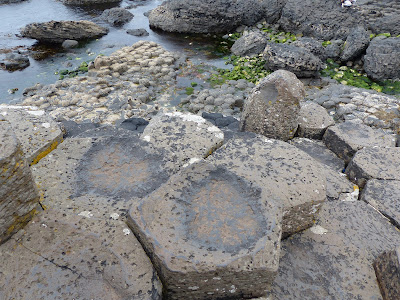Before travelling to
Belfast, I didn't realise how strong the link with
RMS Titanic was there. I always associated the famous liner with Southampton, as that's where it sailed from, but it was actually built in Belfast Harbour and first sailed from there. A visitor exhibition called
Titanic Belfast was opened in 2012 and has become Northern Ireland's most popular tourist attraction.
 |
| Titanic Belfast visitor attraction building |
 |
| sculpture outside Titanic Belfast |
 |
| SS Nomadic, a sister steamship of HMS Titanic, launched in 1911 |
Belfast City Hall is a surprisingly iconic building, and can be visited on a free public tour. The Lord Mayor’s Suite there is also known as ‘the Titanic Rooms’, as craftsmen who worked there went on to work on the famous ship.
 |
| a scale model of RMS Titanic at Belfast City Hall |
 |
| Inside Belfast City Hall |
 |
Albert Memorial Clock Tower
|
Bigfish, on the riverbank, is a giant mosaic sculpture of a salmon whose tiles depict the history of Belfast.
 |
| Bigfish, 10 metres long |
 |
| Custom House, built in 1850s |
Another 'attraction' in the west of Belfast are the Murals, a symbol of the region's past and present political and religious divisions. The Falls Road area is Republican, while nearby Shankhill is a Protestant district.
 |
| an Irish Republican mural showing strike leader Bobby Sands |
 |
| another Republican mural |
 |
| Shankhill Road, Loyalist district |
 |
| Shankhill Road, Loyalist district |
 |
| Shankhill Road, Loyalist district |
 |
| Cupar Way peace wall |
On leaving Belfast we headed further north along the coast. As my husband is a Game of Thrones fan, we visited some of the series' filming locations.
 |
Cushenden Caves (aka 'Shadow birthplace')
|
 |
| Dark Hedges (aka 'Arya's Escape') |
Ever since I was in school I'd always wanted to visit the
Giant's Causeway, an expanse of hexagonal basalt stone columns that are the result of an ancient volcanic eruption.
 |
| Giant's Causeway |
As a UNESCO world heritage site it's perpetually busy, and we were lucky to get photos with no people in them!
 |
| Giant's Causeway, close up |
 |
| Giant's Causeway |
We then headed to
Derry/Londonderry, Northern Ireland's second largest city, and the fourth-largest city on the island of Ireland. The first thing you notice when you arrive is Hands Across The Divide, a bronze sculpture of two men reaching out to each other, symbolising the spirit of reconciliation. It was unveiled in 1992, twenty years after
Bloody Sunday.
 |
| Hands Across The Divide sculpture |
Elsewhere in the city a 1987 cast iron
Anthony Gormley sculpture represents "the two communities divided by religion, culture and politics but united by faith and by being members of the human race".
 |
| Anthony Gormley sculpture |
Derry is a city which I associated with the
Troubles, and which until I visited I didn't realise had such a long, rich and interesting history.
 |
Fountain housing estate in Derry - a Protestant community.
|
Derry is also a walled city, and its walls, completed in 1619, are 8m high and 9m thick, with a circumference of about 1.5km. Warring Catholics and Protestants led to a siege which began on December 7th 1688 and which was to last for 105 days.
 |
| Derry city walls |
When you walk the city walls today you can see reenactments of what life was like during the siege; people were reduced to eating vermin to survive.
 |
| Historical reenactment on Derry city walls. |
 |
| Peace Bridge, Derry |
On leaving Derry we headed south across the border and into
Eire for the rest of our trip.
If you enjoyed this post you might also like:


























No comments:
Post a Comment